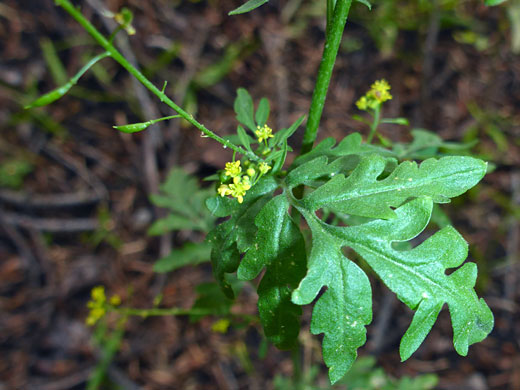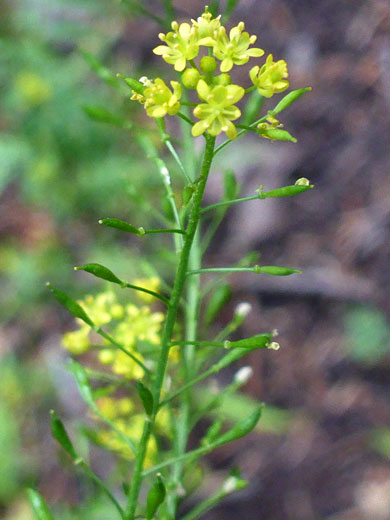Descurainia Californica, Sierra Tansymustard
Plants > Wildflowers > Brassicaceae > Descurainia Californica
Common name:
Sierra tansymustard
Family:
Scientific name:
Descurainia californica
Main flower color:
Range:
California and the Great Basin, east to the Rocky Mountains
Height:
Up to 3 feet
Habitat:
Open woodland, roadsides, disturbed ground, sagebrush; 5,500 to 11,000 feet
Leaves:
Up to 4 inches long, pinnately divided into rounded, coarsely toothed lobes; hairless or sparsely hairy
Season:
June to August
Although widespread all across the Sierra Nevada, descurainia californica or Sierra tansymustard also occurs in many other mountainous areas, eastwards to Wyoming, Colorado and New Mexico. It can be identified most easily by its fruits, which are hairless, relatively short (0.2 inches), widest in the middle and tapering smoothly at either end. Fruits are angled upwards, held at around 45 degrees from the stem branches, and are attached by hairless pedicels about twice as long.
Leaves are pinnately divided into two to four pairs of side lobes, and are sessile along the stem, stalked at the base, with the stalk a little shorter than the blade. Flowers are formed of four spreading, hairless, oblong, yellow-green sepals and four slightly longer oblanceolate yellow petals. The six stamens are ascending, and exserted.
Leaves are pinnately divided into two to four pairs of side lobes, and are sessile along the stem, stalked at the base, with the stalk a little shorter than the blade. Flowers are formed of four spreading, hairless, oblong, yellow-green sepals and four slightly longer oblanceolate yellow petals. The six stamens are ascending, and exserted.
All Contents © Copyright The American Southwest | Comments and Questions | Contribute | Site Map




